Denys Poshyvanyk
On Explaining (Large) Language Models For Code Using Global Code-Based Explanations
Mar 21, 2025Abstract:In recent years, Language Models for Code (LLM4Code) have significantly changed the landscape of software engineering (SE) on downstream tasks, such as code generation, by making software development more efficient. Therefore, a growing interest has emerged in further evaluating these Language Models to homogenize the quality assessment of generated code. As the current evaluation process can significantly overreact on accuracy-based metrics, practitioners often seek methods to interpret LLM4Code outputs beyond canonical benchmarks. While the majority of research reports on code generation effectiveness in terms of expected ground truth, scant attention has been paid to LLMs' explanations. In essence, the decision-making process to generate code is hard to interpret. To bridge this evaluation gap, we introduce code rationales (Code$Q$), a technique with rigorous mathematical underpinning, to identify subsets of tokens that can explain individual code predictions. We conducted a thorough Exploratory Analysis to demonstrate the method's applicability and a User Study to understand the usability of code-based explanations. Our evaluation demonstrates that Code$Q$ is a powerful interpretability method to explain how (less) meaningful input concepts (i.e., natural language particle `at') highly impact output generation. Moreover, participants of this study highlighted Code$Q$'s ability to show a causal relationship between the input and output of the model with readable and informative explanations on code completion and test generation tasks. Additionally, Code$Q$ also helps to uncover model rationale, facilitating comparison with a human rationale to promote a fair level of trust and distrust in the model.
Mapping the Trust Terrain: LLMs in Software Engineering -- Insights and Perspectives
Mar 18, 2025



Abstract:Applications of Large Language Models (LLMs) are rapidly growing in industry and academia for various software engineering (SE) tasks. As these models become more integral to critical processes, ensuring their reliability and trustworthiness becomes essential. Consequently, the concept of trust in these systems is becoming increasingly critical. Well-calibrated trust is important, as excessive trust can lead to security vulnerabilities, and risks, while insufficient trust can hinder innovation. However, the landscape of trust-related concepts in LLMs in SE is relatively unclear, with concepts such as trust, distrust, and trustworthiness lacking clear conceptualizations in the SE community. To bring clarity to the current research status and identify opportunities for future work, we conducted a comprehensive review of $88$ papers: a systematic literature review of $18$ papers focused on LLMs in SE, complemented by an analysis of 70 papers from broader trust literature. Additionally, we conducted a survey study with 25 domain experts to gain insights into practitioners' understanding of trust and identify gaps between existing literature and developers' perceptions. The result of our analysis serves as a roadmap that covers trust-related concepts in LLMs in SE and highlights areas for future exploration.
UniGenCoder: Merging Seq2Seq and Seq2Tree Paradigms for Unified Code Generation
Feb 18, 2025


Abstract:Deep learning-based code generation has completely transformed the way developers write programs today. Existing approaches to code generation have focused either on the Sequence-to-Sequence paradigm, which generates target code as a sequence of tokens, or the Sequence-to-Tree paradigm, which outputs code as a sequence of actions. While these two paradigms are intuitively complementary, their combination has not been previously explored. By comparing the code generated under these two paradigms, we find that integrating them holds significant potential. In this paper, we propose UniGenCoder for code-related generation tasks, which consists of a shared encoder, a shared decoder with a minimal set of additional parameters to unify two paradigms, and a selector that dynamically chooses optimal paradigm for each instance. Also, during the model training, we first perform the multi-task learning and distillation strategies to facilitate knowledge transfer between two paradigms, and then leverage contrastive learning to train the selector. Experimental results on the text-to-code and code-to-code generation tasks demonstrate the effectiveness of our proposed model. We release our code at https://github.com/DeepLearnXMU/UniGenCoder.
The ML Supply Chain in the Era of Software 2.0: Lessons Learned from Hugging Face
Feb 06, 2025Abstract:The last decade has seen widespread adoption of Machine Learning (ML) components in software systems. This has occurred in nearly every domain, from natural language processing to computer vision. These ML components range from relatively simple neural networks to complex and resource-intensive large language models. However, despite this widespread adoption, little is known about the supply chain relationships that produce these models, which can have implications for compliance and security. In this work, we conduct an extensive analysis of 760,460 models and 175,000 datasets mined from the popular model-sharing site Hugging Face. First, we evaluate the current state of documentation in the Hugging Face supply chain, report real-world examples of shortcomings, and offer actionable suggestions for improvement. Next, we analyze the underlying structure of the extant supply chain. Finally, we explore the current licensing landscape against what was reported in prior work and discuss the unique challenges posed in this domain. Our results motivate multiple research avenues, including the need for better license management for ML models/datasets, better support for model documentation, and automated inconsistency checking and validation. We make our research infrastructure and dataset available to facilitate future research.
Toward Neurosymbolic Program Comprehension
Feb 03, 2025


Abstract:Recent advancements in Large Language Models (LLMs) have paved the way for Large Code Models (LCMs), enabling automation in complex software engineering tasks, such as code generation, software testing, and program comprehension, among others. Tools like GitHub Copilot and ChatGPT have shown substantial benefits in supporting developers across various practices. However, the ambition to scale these models to trillion-parameter sizes, exemplified by GPT-4, poses significant challenges that limit the usage of Artificial Intelligence (AI)-based systems powered by large Deep Learning (DL) models. These include rising computational demands for training and deployment and issues related to trustworthiness, bias, and interpretability. Such factors can make managing these models impractical for many organizations, while their "black-box'' nature undermines key aspects, including transparency and accountability. In this paper, we question the prevailing assumption that increasing model parameters is always the optimal path forward, provided there is sufficient new data to learn additional patterns. In particular, we advocate for a Neurosymbolic research direction that combines the strengths of existing DL techniques (e.g., LLMs) with traditional symbolic methods--renowned for their reliability, speed, and determinism. To this end, we outline the core features and present preliminary results for our envisioned approach, aimed at establishing the first Neurosymbolic Program Comprehension (NsPC) framework to aid in identifying defective code components.
How Propense Are Large Language Models at Producing Code Smells? A Benchmarking Study
Dec 25, 2024



Abstract:Large Language Models (LLMs) have shown significant potential in automating software engineering tasks, particularly in code generation. However, current evaluation benchmarks, which primarily focus on accuracy, fall short in assessing the quality of the code generated by these models, specifically their tendency to produce code smells. To address this limitation, we introduce CodeSmellEval, a benchmark designed to evaluate the propensity of LLMs for generating code smells. Our benchmark includes a novel metric: Propensity Smelly Score (PSC), and a curated dataset of method-level code smells: CodeSmellData. To demonstrate the use of CodeSmellEval, we conducted a case study with two state-of-the-art LLMs, CodeLlama and Mistral. The results reveal that both models tend to generate code smells, such as simplifiable-condition and consider-merging-isinstance. These findings highlight the effectiveness of our benchmark in evaluating LLMs, providing valuable insights into their reliability and their propensity to introduce code smells in code generation tasks.
On Interpreting the Effectiveness of Unsupervised Software Traceability with Information Theory
Dec 06, 2024



Abstract:Traceability is a cornerstone of modern software development, ensuring system reliability and facilitating software maintenance. While unsupervised techniques leveraging Information Retrieval (IR) and Machine Learning (ML) methods have been widely used for predicting trace links, their effectiveness remains underexplored. In particular, these techniques often assume traceability patterns are present within textual data - a premise that may not hold universally. Moreover, standard evaluation metrics such as precision, recall, accuracy, or F1 measure can misrepresent the model performance when underlying data distributions are not properly analyzed. Given that automated traceability techniques tend to struggle to establish links, we need further insight into the information limits related to traceability artifacts. In this paper, we propose an approach, TraceXplainer, for using information theory metrics to evaluate and better understand the performance (limits) of unsupervised traceability techniques. Specifically, we introduce self-information, cross-entropy, and mutual information (MI) as metrics to measure the informativeness and reliability of traceability links. Through a comprehensive replication and analysis of well-studied datasets and techniques, we investigate the effectiveness of unsupervised techniques that predict traceability links using IR/ML. This application of TraceXplainer illustrates an imbalance in typical traceability datasets where the source code has on average 1.48 more information bits (i.e., entropy) than the linked documentation. Additionally, we demonstrate that an average MI of 4.81 bits, loss of 1.75, and noise of 0.28 bits signify that there are information-theoretic limits on the effectiveness of unsupervised traceability techniques. We hope these findings spur additional research on understanding the limits and progress of traceability research.
Perspective of Software Engineering Researchers on Machine Learning Practices Regarding Research, Review, and Education
Nov 28, 2024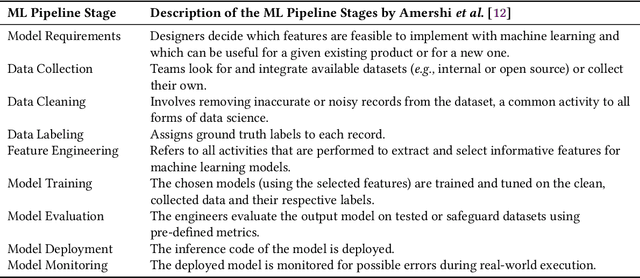
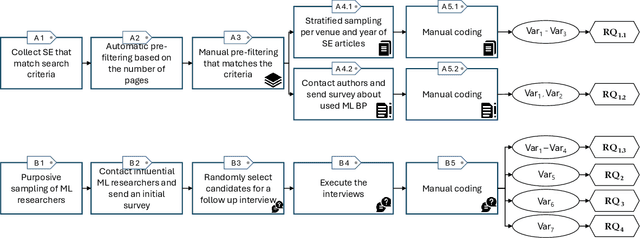
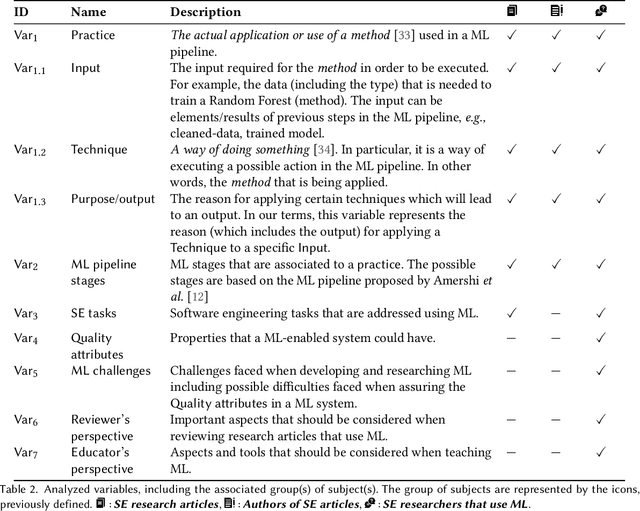
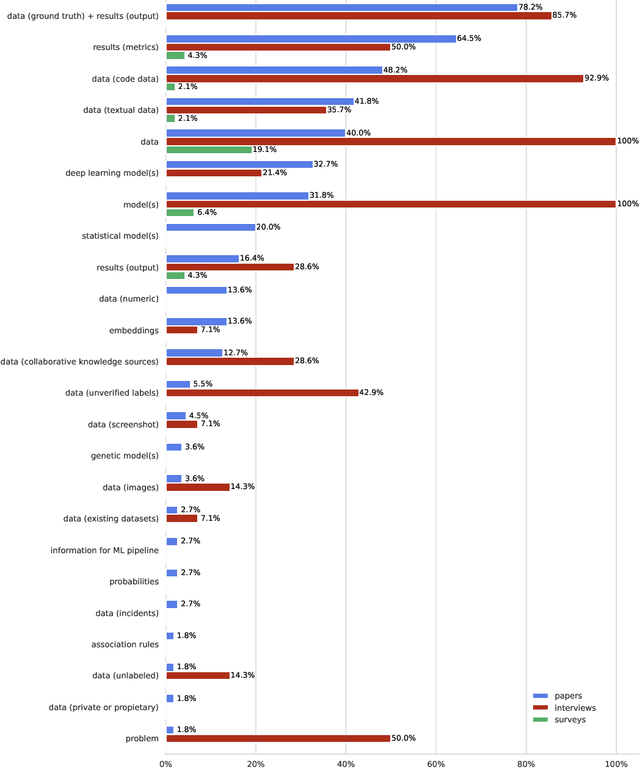
Abstract:Context: Machine Learning (ML) significantly impacts Software Engineering (SE), but studies mainly focus on practitioners, neglecting researchers. This overlooks practices and challenges in teaching, researching, or reviewing ML applications in SE. Objective: This study aims to contribute to the knowledge, about the synergy between ML and SE from the perspective of SE researchers, by providing insights into the practices followed when researching, teaching, and reviewing SE studies that apply ML. Method: We analyzed SE researchers familiar with ML or who authored SE articles using ML, along with the articles themselves. We examined practices, SE tasks addressed with ML, challenges faced, and reviewers' and educators' perspectives using grounded theory coding and qualitative analysis. Results: We found diverse practices focusing on data collection, model training, and evaluation. Some recommended practices (e.g., hyperparameter tuning) appeared in less than 20\% of literature. Common challenges involve data handling, model evaluation (incl. non-functional properties), and involving human expertise in evaluation. Hands-on activities are common in education, though traditional methods persist. Conclusion: Despite accepted practices in applying ML to SE, significant gaps remain. By enhancing guidelines, adopting diverse teaching methods, and emphasizing underrepresented practices, the SE community can bridge these gaps and advance the field.
Developer Perspectives on Licensing and Copyright Issues Arising from Generative AI for Coding
Nov 16, 2024
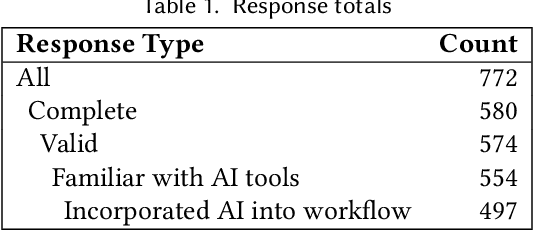


Abstract:Generative AI (GenAI) tools have already started to transform software development practices. Despite their utility in tasks such as writing code, the use of these tools raises important legal questions and potential risks, particularly those associated with copyright law. In the midst of this uncertainty, this paper presents a study jointly conducted by software engineering and legal researchers that surveyed 574 GitHub developers who use GenAI tools for development activities. The survey and follow-up interviews probed the developers' opinions on emerging legal issues as well as their perception of copyrightability, ownership of generated code, and related considerations. We also investigate potential developer misconceptions, the impact of GenAI on developers' work, and developers' awareness of licensing/copyright risks. Qualitative and quantitative analysis showed that developers' opinions on copyright issues vary broadly and that many developers are aware of the nuances these legal questions involve. We provide: (1) a survey of 574 developers on the licensing and copyright aspects of GenAI for coding, (2) a snapshot of practitioners' views at a time when GenAI and perceptions of it are rapidly evolving, and (3) an analysis of developers' views, yielding insights and recommendations that can inform future regulatory decisions in this evolving field.
Towards More Trustworthy and Interpretable LLMs for Code through Syntax-Grounded Explanations
Jul 12, 2024



Abstract:Trustworthiness and interpretability are inextricably linked concepts for LLMs. The more interpretable an LLM is, the more trustworthy it becomes. However, current techniques for interpreting LLMs when applied to code-related tasks largely focus on accuracy measurements, measures of how models react to change, or individual task performance instead of the fine-grained explanations needed at prediction time for greater interpretability, and hence trust. To improve upon this status quo, this paper introduces ASTrust, an interpretability method for LLMs of code that generates explanations grounded in the relationship between model confidence and syntactic structures of programming languages. ASTrust explains generated code in the context of syntax categories based on Abstract Syntax Trees and aids practitioners in understanding model predictions at both local (individual code snippets) and global (larger datasets of code) levels. By distributing and assigning model confidence scores to well-known syntactic structures that exist within ASTs, our approach moves beyond prior techniques that perform token-level confidence mapping by offering a view of model confidence that directly aligns with programming language concepts with which developers are familiar. To put ASTrust into practice, we developed an automated visualization that illustrates the aggregated model confidence scores superimposed on sequence, heat-map, and graph-based visuals of syntactic structures from ASTs. We examine both the practical benefit that ASTrust can provide through a data science study on 12 popular LLMs on a curated set of GitHub repos and the usefulness of ASTrust through a human study.
 Add to Chrome
Add to Chrome Add to Firefox
Add to Firefox Add to Edge
Add to Edge